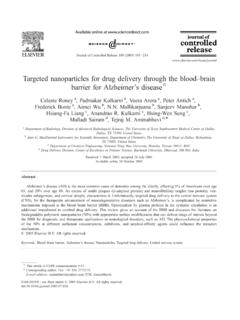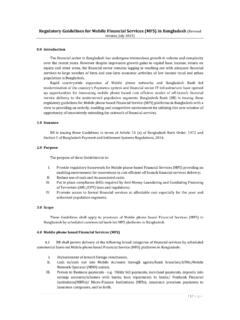Transcription of STRATEGIES TO IMPROVE SERVICE DELIVERY IN …
1 International Journal of Information Technology and Business Management 29th July 2013. 2012 -2013 JITBM & ARF. All rights reserved ISSN 2304-0777 1 STRATEGIES TO IMPROVE SERVICE DELIVERY IN LOCAL AUTHORITIES Charles Makanyeza1, Hardson P. Kwandayi2, Beatrice Nyaboke Ikobe3 1 Lecturer, Department of International Marketing, Chinhoyi University of Technology, Chinhoyi, Zimbabwe 2 Program Director, Faculty of Management and Administration, Africa University, Mutare, Zimbabwe 3 Lecturer, Government of Kenya - Teachers' SERVICE Commission of Kenya, Nairobi, Kenya Corresponding email.
2 ABSTRACT This study sought to identify the causes of poor SERVICE DELIVERY and the STRATEGIES to IMPROVE SERVICE DELIVERY in local authorities using the case of Kajiado Local Authority. Two self-administered questionnaires were designed one for the employees and the other for SERVICE users so as to capture the views of both the employees and SERVICE users. Questionnaires were conveniently distributed to 150 SERVICE users and 100 were returned usable. Questionnaires were also conveniently distributed to 20 employees of Kijiado Local Authority and 20 were returned usable.
3 A mixed approach a combination of quantitative and qualitative methods was taken to analyse data. The findings showed that the major causes of poor SERVICE DELIVERY are councilor interference and political manipulation, corruption and lack of accountability and transparency, inadequate citizen participation, poor human resource policy, failure to manage change, lack of employee capacity, poor planning, and poor monitoring and evaluation. The main STRATEGIES to IMPROVE SERVICE DELIVERY were found to be increasing citizen participation in the affairs of the local authority and partnership with the community in SERVICE DELIVERY , flexible response to SERVICE user complaints, offering value for money and ensuring that SERVICE users pay their bills on time, strategic public SERVICE planning, sound human resource policy that includes capacity building and employee motivation, managing change, dealing with corruption and improving accountability.
4 Segregation of duties between councilors and management of the local authorities, and partnering with other players and outsourcing services. Key words: strategy, SERVICE DELIVERY , public SERVICE DELIVERY , town council, local authority 1. INTRODUCTION Municipal Research and Services Centre (MRSC, 1993) defines SERVICE DELIVERY as the actual producing of a SERVICE such as collecting refuse and disposing it or lighting the streets. Stauss (2005) supports this view and suggests that in economic transactions, it is specialized skills and knowledge that are exchanged for money rather than the physical resources.
5 Whitaker (1980) observes that depending on the kind of SERVICE being offered, each SERVICE has a primary intervention of transforming the customer and that the client himself/herself is the principal beneficiary. As a crucial responsibility of government and government institutions, the public SERVICE should deliver services that a society requires to maintain and IMPROVE its welfare. To do this, government institutions require organizational structures and suitably qualified people who must be supported to deliver the services they are responsible for (Whitaker, 1980).
6 Besley and International Journal of Information Technology and Business Management 29th July 2013. 2012 -2013 JITBM & ARF. All rights reserved ISSN 2304-0777 2 Ghatak (2007) argue that public services are a key determinant of quality of life that is not measured in per capita income.
7 The authors stress that SERVICE DELIVERY is an important feature of the poverty reduction strategy. Hernandez (2006) concurs that services are vital to poverty alleviation and key to realizing the Millennium Development Goals (MDGs) both directly and indirectly, enhancing the availability and affordability of education, health, energy, and information and communication technology services; and alleviating poverty and empowering women through entrepreneurial and employment creation opportunities in services enterprises respectively.
8 According to the Organisation for Economic Co-operation and Development (OECD, 2010), throughout the world cities face the most acute challenges of SERVICE DELIVERY because of fast growing populations. In many countries, developing countries in particular, the issue of SERVICE DELIVERY is a challenge that needs to be addressed given the low quality of SERVICE provision and the pressing needs of the poor (Besley and Ghatak, 2007). Khalid (2010) supports this view when he states that local councils in Malaysia continue face pressure to IMPROVE their SERVICE DELIVERY .
9 The increased level of education of the population has led to a more vocal and more discerning citizenry that expects better services and accountability from its local government. Moreover, rapid industrialization and urbanization of countries have created a challenging environment for the local government (Khalid, 2010). Tamrakar (2010) affirms that in Nepal, public SERVICE DELIVERY has remained lower than what was targeted when Nepal announced DELIVERY of public services to its people through a planned development effort.
10 The fact that people still suffer from many hurdles when they have to get any government services (Tamrakar, 2020) is an indication of poor SERVICE DELIVERY that needs to be addressed. Similarly, the argument by Gwayi (2010) that municipalities in South Africa face serious challenges in implementing SERVICE DELIVERY options that will enhance existing structures in the sphere of local government points towards the need for STRATEGIES to IMPROVE SERVICE DELIVERY . Thus, the problem of SERVICE DELIVERY is not unique to Kenyan towns alone; it is a problem that is faced by many towns in the world, especially in Africa and other developing countries.







